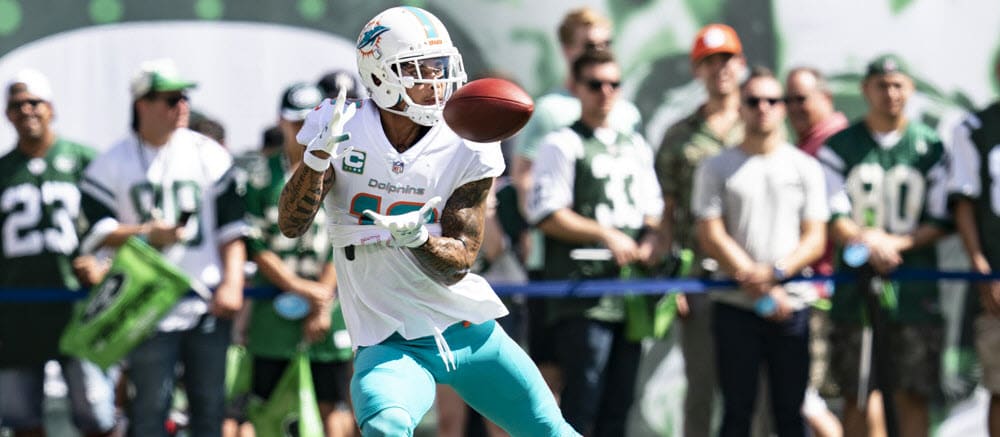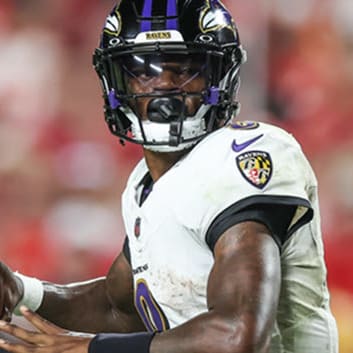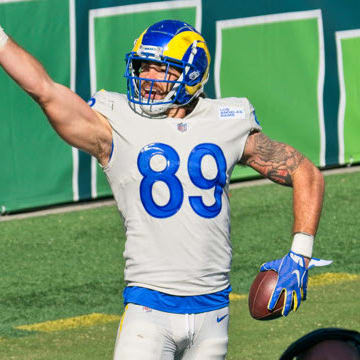This article is part of our Dynasty Strategy series.
Kenny Stills has been in the news quite a bit lately, first for his activism – including publicly criticizing owner Stephen Ross by name – and since then for his inclusion in trade rumors around the Dolphins. Are these two outcomes related? One can only take a big fat freaking guess.
If Stills is to be traded or cut, then it's in any case a huge opportunity for his next team to acquire a substantial wide receiver upgrade at a low cost. The narrative on Stills these days is that he's a one-trick pony, a fly-route guy who offers a deep threat but nothing else otherwise. This is, objectively, completely false. Stills not only has a well-rounded skill set, but he more specifically is likely an above average starting NFL receiver.
None of this is to say that Stills' value is on the rise. His value could very well take a plunge in the upcoming days depending on what happens. But this post does mean to say that Stills is very good for his own part, and just as the uncertainty facing him right now contains a worst-case scenario, it also contains the best-case scenario where one of the league's best receivers leaves one of the league's worst offenses for a potentially better one. It's worth considering both the upside and the downside of this unusual situation.
Let's get the easy part done first. I'll later make the case for Stills as one of the league's best wideouts generally, but to start let's quickly dispel this idea that Stills is a one-dimensional deep-route target. As I said previously, this is objectively untrue. In fact, when Stills declared for the NFL Draft out of Oklahoma, you would have sooner heard the opposite criticism. Before he averaged 16.0 yards per catch in the NFL, Stills primarily functioned as a possession receiver at Oklahoma, where he averaged 12.7 yards per catch, including 11.7 per catch in his final collegiate season. He was very effective in this capacity, catching 204 passes for 2,594 yards and 24 touchdowns before turning 21. If anything, he was less proven as a downfield threat. Try to watch this tape of Stills at Oklahoma and give a straight-faced comment that he can't play underneath
Two things changed the perception of Stills into one that pigeonholes him as a downfield specialist. The first was the combine, where he ran faster than expected with a 4.38-second 40-yard dash. The second was his selection in the fifth round by the Saints, who actually did largely use him as a downfield specialist in his first two NFL seasons. Because Stills is a very good wide receiver with a rounded skill set, he thrived in this new role despite it being somewhat foreign to him.
It's difficult to overstate Stills' dominance in those first two seasons. He was improbably efficient, and you know he wasn't just a product of the Drew Brees system because Stills outproduced the other New Orleans pass catchers. The Saints passing game completed 68.85 percent of its passes at 7.71 yards per pass in those two years, a span in which Stills caught 95 of 134 targets for 1,572 yards – good for an insane rate of 11.73 yards per target at a 70.9 percent catch rate. He did this all before turning 23 years old. Only good receivers can do things like this.
Stills averaged 16.55 yards per catch in New Orleans, so it would be reasonable to typecast him as a downfield wideout if you were unaware of his Oklahoma career. But if you did know of Stills' Oklahoma career, and if you furthermore took into account the structure of the New Orleans offenses those years, you'd know that Stills specialized as a downfield receiver because of team fit rather than skill set. The Saints had at the time built their underneath passing game very specifically around Marques Colston, Lance Moore, Pierre Thomas, and Darren Sproles. If there had been underneath targets up for grabs, Stills would have claimed them and done well with them. But most of the available snaps and targets were with the downfield tasks, so Stills played there and dominated all the same.
The gravy train tore off the rails when the Saints traded Stills to the Dolphins following the 2014 season, the compensation being a third-round pick and then-starting linebacker Dannell Ellerbe. Injuries limited Ellerbe to just 15 games over the next two years, and the draft pick turned out to be cornerback P.J. Williams, who has been less than great.
Stills was in any case banished to Miami, where the typecast stuck, in large part to clear out slot snaps and underneath targets for Jarvis Landry. Stills continued to run far downfield, but instead of the pinpoint precision of Drew Brees, Stills was subjected to the infuriating inaccuracy of Ryan Tannehill, and Brock Osweiler more recently. The results predictably suffered. Since catching 70.9 percent of his targets at 11.73 yards a pop with the Saints, Stills' Miami career floundered to the tune of a 52.4 percent catch rate at 8.2 yards per target. The Dolphins passing game as a whole completed 63.6 percent of its passes at 7.1 yards per attempt over the same span.
The nearly 10-point divide between Stills' catch rate and the Dolphins' completion rate is admittedly quite ugly, and at a glance it isn't necessarily offset by 1.1-yard distinction in per-attempt yardage. But that's only to say that a glance isn't sufficient. When you look at the broader fit with Stills and the Dolphins offense, it's pretty easy to rule out failure on his part.
We can't know for sure that Stills was getting open in Miami as reliably as he did in New Orleans. But we can more or less prove that the anemic catch rate was reflective of the quarterback play rather than anything within Stills' control. Stills finished last year with 37 catches for 553 yards and six touchdowns on 64 targets (57.8 percent catch rate, 8.6 YPT), with the average depth of target at a substantial 15.8 yards.
You might notice that this means Stills' per-catch average lags behind the average depth of target – 14.95 per catch compared to 15.8 yards average depth of target. This is unusual, and it isn't explained by bad hands on Stills' part – his 4.7 percent drop rate (three out of 64) was average (47th percentile). Unless I missed someone, only two other players last year totaled 550 receiving yards or more while averaging more yardage depth per target than yards per catch. They're Robby Anderson (15.0 YPR, 15.6 ADOT) and Zay Jones (11.6 YPR, 12.2 ADOT), both of whom were catching passes from raw rookie quarterbacks.
What this is all means is this: Stills' role in Miami entailed running the majority of his routes in a part of the field where the target quality was prohibitively poor, to the point that it was generally true to say that his viable targets mostly occurred on underneath routes. If most of a player's viable targets occur in a setting where they rarely find themselves, then the player's output is almost categorically doomed.
In hindsight, the cumulative Miami passing production padded its catch rate by piling up dubious underneath targets toward Landry and Danny Amendola, who combined for 375 receptions for 3,855 yards (69.8 percent catch rate, 7.18 YPT) and 18 touchdowns. The passing game juiced its YPA best it could with its low-quality targets to Stills, whose 8.2 YPT average came at the expense of his catch rate. There's further insight to be found in the fact that Stills' 24 touchdowns in the sample grant him a touchdown rate of 7.67 percent – more than twice that of Landry and Amendola, who combined for a 3.35 percent touchdown rate. Clearly, the player is quality but the targets are not.
I can anticipate a reasonable criticism of this argument. Without disputing the poor quality of targets in Miami, someone could argue that Stills was nonetheless the product of the New Orleans-Drew Brees system when he posted the remarkable production from his first two seasons. The engine of this argument is the case of fellow former Saints wideout Willie Snead. Snead too enjoyed an improbably successful two seasons in New Orleans prior to his unceremonious exit. Indeed, he appeared to be the direct Stills replacement in a lot of ways. From 2015 to 2016, Snead caught 141 passes for 1,879 yards and seven touchdowns on 205 targets. The correct take here, in my opinion, is that Snead, while still serviceable otherwise, really was a product of the system, while Stills by contrast was a good player on his own part who otherwise benefited further from the system. There are several reasons to think this.
First, it's important to recall that Stills did his damage as a rookie and second-year player after leaving Oklahoma following his true junior season. Snead actually spent his rookie year on the Carolina and New Orleans practice squads, so he accumulated his production from ages roughly 23 to 24, whereas Stills didn't turn 23 until the April following his second season.
Not only did Stills produce his numbers at nearly two years younger than Snead, but the peripheral numbers otherwise hint further at Stills' superiority even without adjusting for age. Snead caught 68.78 percent of his targets at 9.17 yards per target in an offense that completed 69.55 percent of its passes at 7.77 yards per attempt. Stills caught 70.9 percent of his targets at 11.73 yards per target in an offense that completed 68.85 percent of its passes at 7.71 yards per attempt. So even with a nearly two-year advantage while playing in a more productive broader passing game, Snead still was safely outdone by Stills. So we know Stills was the more productive player in a vacuum – to the tune of 2.12 catch percentage points and 2.56 yards per target – even before factoring in Snead's age or team advantage.
Beyond that it's important to note that Snead and Stills are very different tools-wise and this manifests meaningfully in their respective skill sets. Snead is a slot specialist who ran a 4.56-second 40 at the Ball State pro day. With a 4.38-second 40 at the combine, Stills needs less accommodation to separate from coverage. Whereas Stills' speed at least buttresses the false premise that he should function as a downfield specialist, Snead's comparative lack of speed means he likely would have fared far worse than Stills if forced to play the role Stills has in Miami.
If you still need a bit more, then consider the strength of Stills' prospect profile, which far exceeds that of almost any other fifth-round wide receiver pick. Stills was a top recruit at Oklahoma and was highly productive for each of his three seasons, buoying the elite Sooners passing game and totaling 204 catches for 2,594 yards and 24 touchdowns in 38 games even as he competed with future NFL prospects like Ryan Broyles, Sterling Shepard, Justin Brown, and Jalen Saunders for targets.
To produce like that before turning 21 and then run a 4.38-second 40-yard dash at the Combine would normally lock you into the second day of the draft, so that Stills fell to the fifth round can't be an indictment against his talent level. Stills fell for character judgment reasons. One could point toward Stills' DUI arrest following his freshman year as the sufficient cause, but I'd point toward Justin Blackmon (first round), Michael Floyd (first round), and Tyler Boyd (third round) as evidence that it can't explain Stills' descent entirely. I think it's reasonable to posit that Stills' free-thinking, strong-willed personality was held against him even back then, and if not that, then a photo of Stills in a dress probably played some role otherwise (seriously).
If Miami is really looking to trade or cut Stills, then any ambitious offense in the league should be interested in acquiring him. I realize there's no indication of such a market at the moment, but that reflects poorly on the NFL if so. There's a strong chance that Stills is one of the best receivers in the league, and if you merely give him a quarterback who provides quality downfield targets, the box score results would make this almost immediately clear.












